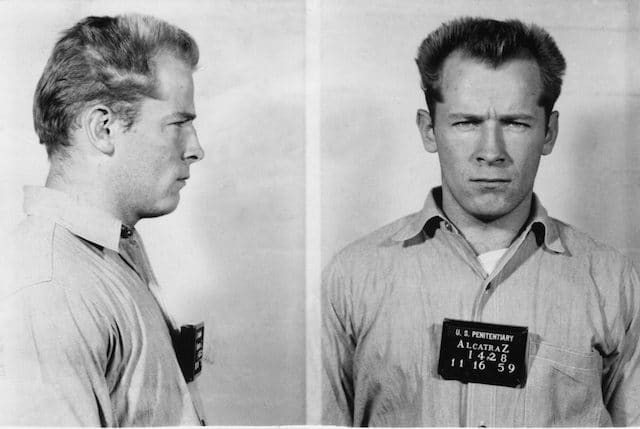Organized crime has become a very hard to understand facet of the modern world. Arguably, no one wants to support crime but, by the same token, we have a habit of elevating organized crime figures to a kind of hero status. You need to look no further than Tony Soprano to appreciate that. And while you could argue he’s fictitious, the number of movies about people like Al Capone and Bugsy Siegel supports the idea that our culture is really into their exploits. But part of any anti-hero’s story arc is their inevitable downfall and, in real life, many of these figures come to ends that are just as dramatic as their lives.
10. The Hitman Taken Out by a Hitman

Alexander Solonik was one of the most notorious hitmen in history, rising to prominence at a time when hitmen were working for as little as $500 a job in the 1990s. He famously took out high profile targets, including mob bosses.
Solonik had served time in the military and the police and was notoriously brutal in performing his duties. The police fired him after just six months for brutality. Once he turned to crime, he was even more unhinged, but punishing him proved to be nearly impossible. During a rape trial, he leapt from a window and escaped in a hearse. When he was caught again, he spent two years in Ulyanovsk prison before escaping. Later, after having a shootout inside a police station, he was caught and incarcerated once more. Despite that, he escaped from Matrosskaya Tishina prison, the only inmate to accomplish that feat at the time.
Solonik fled to Greece to live out the rest of his days and plot the murders of the crime bosses who had turned on him. His home was bugged, however, and his former employers sent hitman Sasha Soldat to kill him. Solonik was actually friends with Soldat, so when the killer arrived, Solonik let him in without hesitation. His strangled body was found by authorities sometime later.
9. Matteo Denaro Has Been on the Lam for 30 Years

Make no mistake, mob boss Matteo Denaro has done some bad stuff. He’s wanted in connection with over 50 murders, not to mention drug trafficking, bombings and extortion.He’s been on the radar of law enforcement for decades. So what was his ultimate fate? No one knows. Denaro has been on the lam since June, 1993. In 30 years, law enforcement has been unable to catch up with him. This despite his brags of being able to fill a cemetery with his victims, which included the 11-year-old son of a rival mob boss.
In 2021, some hapless Formula 1 racing fan was blindfolded and dragged away by Dutch police when they mistook him for Denaro, who remains one of Europe’s most wanted criminals and the number one criminal in Italy after all these years. The fan was later released when it was determined he was just a guy who looked vaguely like Denaro.
8. Whitey Bulger Was a Victim of Government LSD Experiments

There was a time when Whitey Bulger was the most wanted man on the FBI’s list behind Osama bin Laden. Bulger was wanted for 19 murders back in 1994 and he wasn’t caught until 2011. Bulger was brutally murdered in prison at age 89. Other inmates beat him with a padlock in a sock and even tried to gouge his eyes out. An inauspicious end to the career of one of the most famous mobsters in American history. But there’s more to his story than a brutal life that met a brutal death.
Bulger had tried to redeem himself by turning informant at one point. At his trial, this didn’t do much to help keep him from prison. But after his sentencing, he started corresponding with one of the jurors. She learned, over a series of letters, that Bulger had been subject to CIA experimentation with LSD after his first arrest. This was what many of us now know as project MK Ultra.
Bulger said he was told that they were looking for a cure for schizophrenia. He was not informed about what drugs he was being given. And they dosed him around 50 times. Apparently, he had never been prone to violence before the experiments.
The juror said, had she known about the experiments, she never would have convicted Bulger.
7. Vincent Gigante Faked Insanity for Decades

In the acting world, method acting is when an actor commits to a role, even when the camera is off. So it’s playing pretend no matter what. It sounds tiresome in that context, but when your freedom is on the line, maybe it makes more sense. And maybe that’s what Vincent Gigante thought when he committed to acting insane for years.
Gigante ran the Genovese crime family for decades and amassed a fortune of $100 million in the process. In an effort to elude law enforcement, or at least prosecution, he pretended to be insane constantly. He would walk around town in a robe and slippers, pee on the street, mumble to himself and seem like a harmless old kook. It got him the nickname of the Oddfather. According to law enforcement, this was a decades-long ruse to help evade prosecution but making it seem like he couldn’t possibly be the leader of a crime family.
Gigante ended up being found competent to stand trial in 1997. He died in prison in 2005.
6. Frank Gusenberg Got Shot 14 Times and Denied It

Nobody likes a snitch in the mob world. Call it honor among thieves, but the idea that one criminal will turn on another, even if they’re rivals, is looked down upon. So when someone does turn informant, their chances of being assaulted or even killed are remarkably high. But how far do some people take it? As far as Frank Gusenberg did.
Gusenberg was a hitman for the mob and was involved in the infamous St. Valentine’s Day Massacre in 1929. Seven gangsters were shot and killed by a rival gang disguised as police. One of the victims was Gusenberg, who was shot a staggering 14 times. His six companions were dead already and Gusenberg was amazingly still alive. When police arrived, they asked him who shot him. Gusenberg said, “no one shot me.”
With six companions, including his own brother, on ice already and his own fate pretty much sealed, the man refused to rat on the killers. He died of his injuries a few hours later.
5. Richard Blass Cheated Death Many Times

Canada has a reputation for politeness and peacekeeping, but that doesn’t mean their criminals necessarily follow those stereotypes. Richard Blass is a prime example of a man who pushed the envelope, living and dying by a brutal creed.
Blass was known as “The Cat” not because he was agile or sleek, but because he had several lives to spare. He survived three separate assassination attempts in the span of two months. After trying and failing to murder a rival mobster, the rival returned the favor, failing to kill Blass in the process. Two weeks later, they burned down the hotel where he was staying, failing to kill him a second time. A couple of months later, he was actually shot in the head while fleeing the third assassination attempt, but still drove himself to a hospital.
Blass had a serious hatred of Italians, not just rival criminals but anyone of Italian descent, and was wanted for the murders of numerous Italian citizens of Montreal. It wasn’t until he shot a police officer that he was finally caught and sent to jail, from which he soon escaped. When he was caught and sent back, he managed to escape again several years later.
Instead of lying low, Blass hunted down the witnesses who had helped convict him and killed them. He then killed the witnesses to that killing. A manhunt ensued and when police finally found him, they shot him 27 times.
Years later, one of the officers at the scene who had said they shot Blass because he came at them with a gun admitted that they had surprised the gangster and all he had in his hands was a sock.
4. John Veasey Was Invincible

In the 1990s, the mob scene was heating up in Philadelphia and John Veasey was hired to be extra muscle during a particularly bloody time. He was paid to kill people, and he was apparently good at it. He killed several rival members of the gang, but at some point he began to feel bad about what he was doing. After talking with his brother, he decided to contact the FBI and turn informant. His cover was blown in just three days and his own gang put a hit out on him.
Veasey wasn’t wearing a wire when his mob associates invited him to a meeting in an apartment. The entire room was coated in plastic, but, being a mob hitman, he didn’t think anything of it. He worked in plastic rooms all the time. Bafflingly, the associates told Veasey the room was being painted, and he believed them.
The men shot Veasey three times in the back of the head and once in the chest. It didn’t work. Veasey pulled a knife from one of his attackers, stabbed him, and ran away. He later went on to testify against the whole crime family and, presumably, he’s still alive to this day with a new identity.
3. Rocco Perri

Al Capone is arguably the biggest name in American organized crime history. But if you went north of the border around the same time, you may have heard word of his Canadian counterpart, Rocco Perri. Perri was a bootlegger and actually worked with Capone, running alcohol from Canada to Chicago for Capone’s outfit. His criminal dealings were no secret, either. He even bragged to his local paper that he ran a bootlegging operation and it was so fine tuned his guys didn’t even need guns. His belief was that bootleggers just needed to outrun cops, not shoot them. Anyone who got caught was at fault for being too slow.
His time as a crime boss allowed him to amass a fortune, which is still being contested by his family members to this day. That’s because, one day in 1944, Rocco Perri went out for a walk. No one ever saw him again. This occurred at the height of his criminal career, and speculation ran rampant that one of two things happened. It was possible rival gangsters simply killed him. But some family members think he walked away literally and figuratively, starting a new life south of the border after learning of a plot to kill him.
2. Tokyo Joe Survived a Hit and Turned Informant

Ken Eto was known as Tokyo Joe during his mob days. He ran the Asian gambling racket in Chicago and, during the 1980s, he flipped on his associates and ended up helping the FBI put 15 mobsters behind bars.
Eto’s about face began when he was indicted on federal gambling charges. Mob bosses feared that Eto was a danger to keep around. They weren’t wrong. The mobster had endured Japanese internment camps as a young man and was willing to do what he needed to do to survive. The syndicate put a hit out on Eto after he got out of jail in 1983.
Two hitmen approached Eto in his parked car. They fired three shots into his head at point blank range and left. Neither of the men bothered to check Eto for a pulse, of course, because who survives three shots to the head? Well, John Veasey did, and so did Ken Eto.
Realizing his options were limited, Eto became an informant. He testified against mobsters, politicians, and even Chicago’s Chief of Detectives. Eto died in the year 2004 at age 84. He’d been living in witness protection since he turned informant.
1. Amado Fuentes Suffered an Unexpected Fate

Amado Fuentes was a major drug kingpin in Mexico as far back as the 1980s. His reach and reputation only grew from there. By the 1990s, he was perhaps the most feared man in Mexico. He killed the head of the Juarez Cartel and took over. It’s estimated he made about $25 billion during his reign.
With police in Mexico and the US on his trail, Fuentes decided to give them the slip by getting plastic surgery. In 1997, he went in for liposuction and to have his face altered. And then, in a surprise to everyone, he had a heart attack under anesthesia and died on the table.
Many people refused to believe it was true, and Fuentes’ rotting corpse was actually put on display for journalists to take pictures of to prove it was him. To this day, some people think it was a fake and Fuentes went underground. But he’s never been seen since.